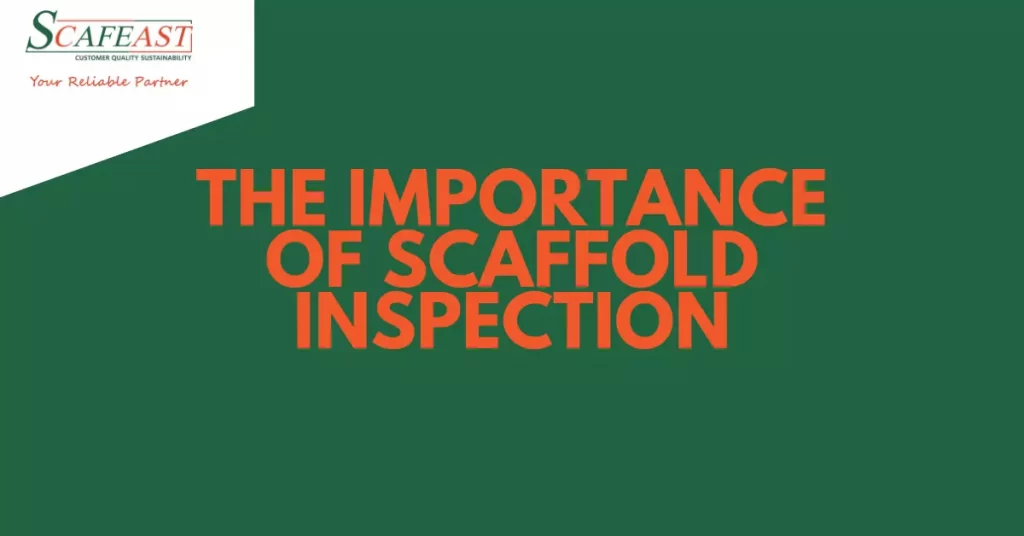Scaffolding
The Importance Scaffold Inspections
Scaffolds are temporary structures erected on construction sites to complete elevated work. Scaffolds exist to improve workplace safety. Unfortunately, simply assembling such platforms does not guarantee security. Accidents still occur on these structures ranging from bad luck to an incident resulting from an inadequate inspection. Failure of inspection can cause injury or death which is why all scaffolding must be investigated to ensure safety procedures are being followed.
Who is responsible?
Multiple parties carry the responsibility to establish scaffolds on a worksite as stable. Part of the onus is on manufacturers and suppliers such as Scafeast. Every day companies, including Scafeast, undertake rigorous testing to ensure all sets and components are durable and not defective. After examination and approval by WorkSafe, are components made available for sale to businesses. Without quality control, the rate of defective products would increase and exacerbate any malpractice occurring on site.
Worksite coordinators and officers also share the burden. The project is under their direct supervision, and any attempt to pass off equipment discovered as faulty by scaffolders is a breach of workplace occupational health and safety. Even worse is if an accident occurs, the consequences of the potential tragedy will be greater than monetary.
The scaffolders hired to install hired or purchased scaffolding are also responsible. Scaffolders must exercise their training to identify risks and raise issues with supervisors over faulty components to unstable terrain. It is also vital that the scaffolder is aware of the extent of their qualifications.
Even the workers operating on the elevated platform have a responsibility. It is vital workers understand safety measures to take when labouring and take care to exercise appropriate procedures for their health and safety along with the people passing below.
Scaffolder licencing?
WHS regulation mandates that scaffolders undergo training to receive certificates to construct towers. There are three tiers though, different procedures and scaffolding structures have varying difficulties.
Basic scaffolding licence SB
Commonplace jobs on the majority of work sites. These include assembling modular and bracket scaffolds, ropes, and fall arrest systems.
Intermediate scaffolding licence SI
Projects involving greater complexity, including cantilevered, spur, tube and coupler scaffolds, sloping platforms, safety screens and shutters.
Advanced scaffolding licence SA
The highest tier for complicated jobs involving cantilevered hoists, hung and suspended scaffolds.
Different licencing levels exist for a good reason. Scaffolders should not undertake a job they are uncomfortable, unfamiliar with, or that’s outside of what their licence permits. Finishing a job with a lack of knowledge or experience can result in the incorrect assembly of the scaffold, creating unstable and dangerous structures for everyone on a worksite.
Scaffold guidelines and inspections
Once a scaffold is standing, necessary inspections are required to confirm its safety. Any towers with a fall distance above four metres must pass the essential checks. Management must ensure scaffolds have written confirmation by a competent individual that it has passed inspection. Inspections include after an incident or weather event that could compromise the structure, repairs or every 30 days. Any issues mustn’t be unattended as they only contribute to a higher risk of accidents. All faults must be repaired and re-inspected to guarantee the platform’s stability. All inspections must be recorded on Scaffold Tags that are attached to structure.
Handover inspection
A handover inspection is required after the assembly with a certificate provided by the competent individual and upon subsequent repairs.
Post-handover inspections
Regular inspections continue once the scaffold is in use. Inspections should also include components not currently in use but stored in exposed environments as they too can be subject to corrosion. Certificates and additional documents are essential to ensure scaffolds are thoroughly checked and protect those involved by demonstrating that the event could not have been reasonably foreseeable. Through regular scrutiny of products, scaffolders and labourers continue their work in an uninterrupted and secure environment.
Scaffold safety is vital in maintaining the overall security of an ongoing construction project. The responsibility falls on all parties in the supply chain to uphold assurances about the stability of the scaffold towers they produce and use. Licences based on the level of training ensures scaffolders are suited to the projects they undertake and complicated tasks aren’t left to less competent workers. The extensive guidelines and regulations surrounding scaffold inspection before, during and after usage minimise defects going undetected and maintains workplace safety for the duration of the project. Without these checks and balances, labourers at the mercy faulty or mismanaged equipment and sites

